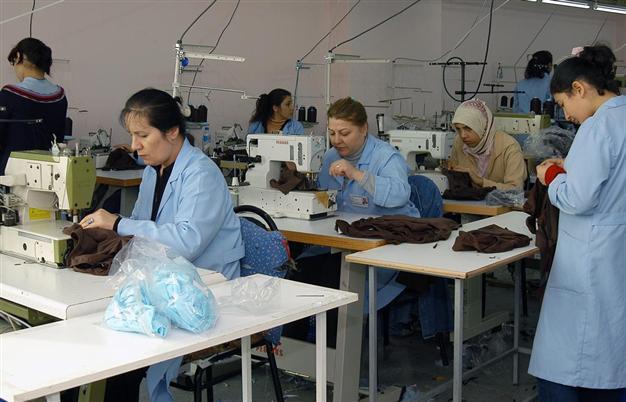More urban women join the workforce in Turkey
Mustafa SÖNMEZ

The number of employed women in urban regions, which was 3.2 million in February 2008, rose to around 4.8 million in February 2013, an increase of over 1.5 million women employed.
Recent figures indicate that the growth in the number of employed women has sped up, while the gap between women and men is narrowing somewhat. When we leave aside the agricultural sector, the number of employed women, which was 3.2 million in February 2008, rose to around 4.8 million in February 2013, amounting to an approximately 50 percent increase within six years. We are talking about an increase of over 1.5 million women employed in urban areas within the last six years.

The neoliberal capital accumulation process, which gained speed with the Justice and Development Party (AKP) government, triggered and sped up migration from rural to urban areas, especially to the major cities of Turkey. Women who were basically regarded as “non-paid family workers” in rural and agricultural spheres were initially registered with a status of “housewife” after migrating to cities. However, as the effects of the global crisis began to be heavily felt in households in 2008, women also joined the labor force market to contribute to family budgets, and thus became registered in the “labor force” in the records. Those who searched without success for a job were recorded as “unemployed,” and the number of officially unemployed women, which was 691,000 in 2008, made up 12 percent of the total women labor force. When the data is further narrowed down by excluding agriculture, it is evident that about 18 percent of the women in the labor force were unemployed. This rate was very high, especially when considered with the country’s young population.
Incentives for women Because a considerable number of women were searching for jobs, the AKP government provided incentives to the firms affected by the crisis. It announced that it would not receive the social security institution (SGK) premium that falls to the employer’s share from women with minimum wages, which means that this would be transferred to the SGK from the budget and this would be practiced in stages over a five year period.
The incentives reached their target. In particular, the number of women employees in the service sector rapidly increased. In 2009, when the economy shrank by about 5 percent, the growth was not that much, but in 2010 and 2011, when the economy achieved a domestic-based growth of about 9 percent for each year - and even in 2012, when growth remained at 2 percent - the increase in women employment continued, finally reaching 4.8 million in February 2013. Some 1.3 million of these, or 27 percent, are unregistered employees. Still, the total share of women in the non-agricultural employment rate has risen from 20 to 25 percent.
Women in the service sector By February 2013, the total number of employed women reached 7.2 million, 34 percent of whom are employed in agriculture. When non-agricultural data is observed, it is seen that 1.1 million women were employed in the production industry, while the service sector has become the sector with the overall highest number of women. In this conjuncture, where industry and production declines and urban profits, interests, imports, and materialization in basic public services have become more prominent, it is seen that only 25 percent of the non-agricultural employed women are in the industrial sector, while 75 percent are employed in the service sector.

The women in industry mostly work in fields based on cheap labor forces such as food, garments and textiles. These industries are mostly located in Istanbul and its industrial neighbors such as the provinces of Tekirdağ, Kocaeli and Bursa.
In the service sector, on the other hand, women are mostly employed in the fields of commerce, education and health. As expected, the retail sector, which is a recently rising power, particularly employs a lot of young women. In addition, in the education and health service sectors, the situation of women consists of flexible working conditions and sub-contractor employment.
For the conservative AKP regime, the primary duties of women are to do housework, and bear and raise children. However, the very same AKP regime also has a neoliberal side. Whether conservative or not, as all neoliberal governments, it raises its reserve army of employees through women, using them as a parameter lowering wages against men. It also knows how to use women’s “productive, patient, and compatible” characteristics for increasing exploitation rates in general. So, women’s employment is
not simply randomly encouraged.
Unjust treatmentWomen’s proletarization and active participation in the labor force in a concrete way is, of course, a positive step for the liberation of women. Going outside the home does not only mean getting to know the cruel face of capital as a labor force; it also means facing all kinds of inequalities including ethnic, religious and gender-based discrimination, and intolerance toward diverse cultures and identities.
The working woman also has a chance to see how the identity struggle and the economic struggle for a job and fair wages have melded together. She will also see what happens outside home from the position of a certain identity such as Kurd or Alevi. However, “identifying and understanding” cannot happen spontaneously. The woman needs to be involved in some sort of organization in which worker leaders and guides can show her how to look from that perspective.
The quantitative increase of employed women bears importance, but a qualitative transformation experienced by women would be the real revolution. Those willing to change life must be much more ready for this.
